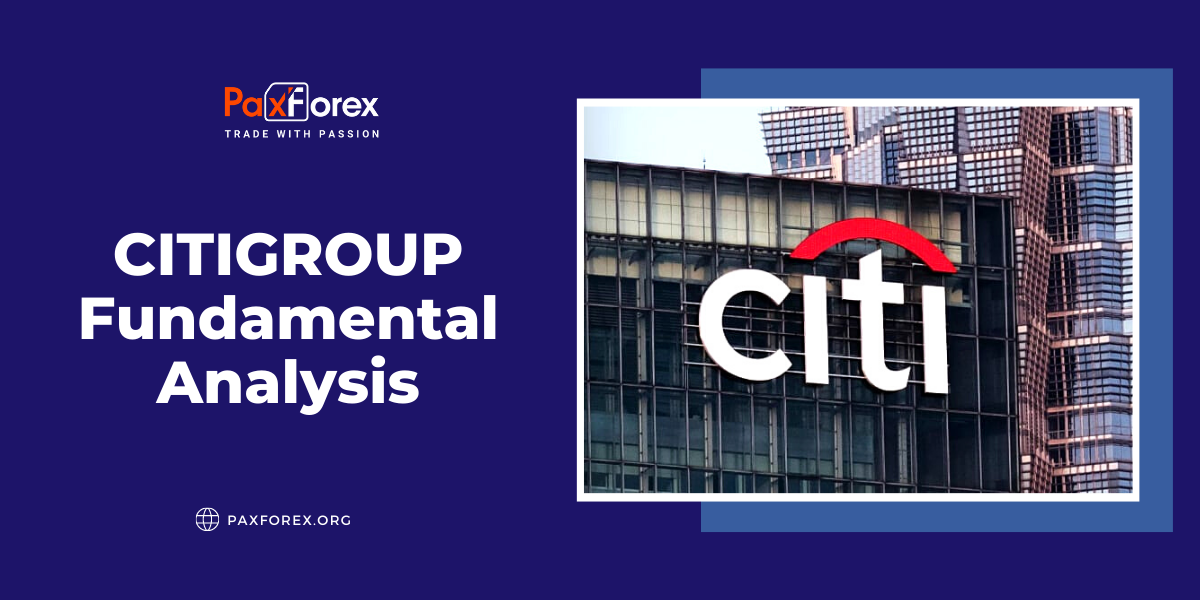
Source: PaxForex Premium Analytics Portal, Fundamental Insight
Since a disappointing investor day earlier this year when management announced new medium-term financial targets that failed to impress the market, Citigroup shares have continued to fall.
The situation has only worsened since Russia invaded Ukraine, complicating the bank's previous decision to sell its consumer banking unit in Russia and increasing the likelihood that the bank will incur large losses from the sale of that unit. As Citigroup reports earnings later this week, here are some things to watch closely.
Since the investor's day is past, and the bank's transformation looks like a multi-year journey, Citigroup doesn't have many near-term catalysts. There are rising interest rates, and an end to the conflict in Ukraine would certainly help, too.
But other than those, the only important near-term catalyst is the possibility of Citigroup continuing to buy back its stock this year while the stock is trading at depressed levels. The stock is trading at less than 60% of book value (TBV), or Citi's net worth, which creates an attractive opportunity for a stock buyback. When banks buy back shares that are trading below TBV, the math works so that the buyback increases the TBV of the bank relative to which the banks are trading.
But the big question is whether the bank can buy back more shares this year. The allocation of capital to banks depends on a bank's regulatory capital requirements, chief among which is the tier one capital ratio (CET1). This is a measure of a bank's core capital expressed as a percentage of its risk-weighted assets, such as loans. Banks have minimum thresholds that they must maintain as well as their internal ratios, so capital for dividends and share repurchases is made up of excess capital more than these CET1 ratios and earnings for each quarter.
Citigroup currently has a CET1 ratio of 12.2%, well above the current requirement of 10.5% as well as its internal target of 11.5%. Citigroup had to suspend share repurchases in the fourth quarter of 2021 to get around the new capital rule and then resume repurchases in the first quarter of this year. However, the bank may face challenges in conducting meaningful buybacks during the remainder of 2021.
One problem is that CFO Mark Mason said at Citigroup's Investor Day in March that the bank expects CET1 requirements to increase in early 2023 (these regulatory requirements can change from year to year), so the bank will have to increase CET1 to 12% CET1 by the end of 2022, which leaves a little capital surplus.
Analysts on average expect Citigroup's earnings to be about $13.6 billion this year, but Citigroup must cover its dividends, and there could be expenses as the bank sells its international consumer banking units.
Last year, as part of a renewal strategy, Chief Executive Officer Jane Fraser announced that the bank would sell 13 international consumer banking divisions that she believed were inefficient and not scalable. Earlier this year, the bank also announced the sale of its very profitable consumer banking division in Mexico.
Some of these could result in significant costs. For example, the bank's withdrawal from South Korea resulted in a $1.2 billion drop in fourth-quarter earnings before interest and taxes. Citigroup could face other costs associated with the exit and recently warned that it could lose up to $4 billion on its operations in Russia.
The good news is that selling 13 international markets would free up about $7 billion in the capital, and selling Mexico would free up another $4 or $5 billion in the capital. In addition, the sale of these markets could reduce Citigroup's regulatory capital requirements over time, which would free up even more capital.
Citigroup has already sold and exited some of its international consumer banking divisions, but selling the Mexico division is much more complicated and could take some time. It all depends on the timing and closing of the deals, which is also complicated by the fact that the bank may have higher CET1 ratio requirements next year.
Hopefully, the bank's management will report on potential share repurchases at the time of the earnings report. If the bank can do more buybacks this year while its stock is trading well below TBV, it could cause a small rally in the stock.
A rise in TBV would be extremely helpful in the long run, as banks trade depending on their TBV, so when TBV rises, the likelihood that the stock price will follow is increased.
While Citigroup has a lot of work to do, given that similar stocks are trading well above TBV and some are trading at nearly 200% TBV, if Citigroup can show signs of significant progress, the stock could return to 100% TBV in the long run, so the higher the TBV, the better for shareholders.
As long as the price is below the 58.00 level, follow the recommendations below:
- Time frame: D1
- Recommendation: short position
- Entry point: 50.43
- Take Profit 1: 49.00
- Take Profit 2: 45.00
Alternative scenario:
If the level of 58.00 is broken-out, follow the recommendations below:
- Time frame: D1
- Recommendation: long position
- Entry point: 58.00
- Take Profit 1: 61.50
- Take Profit 2: 66.00













